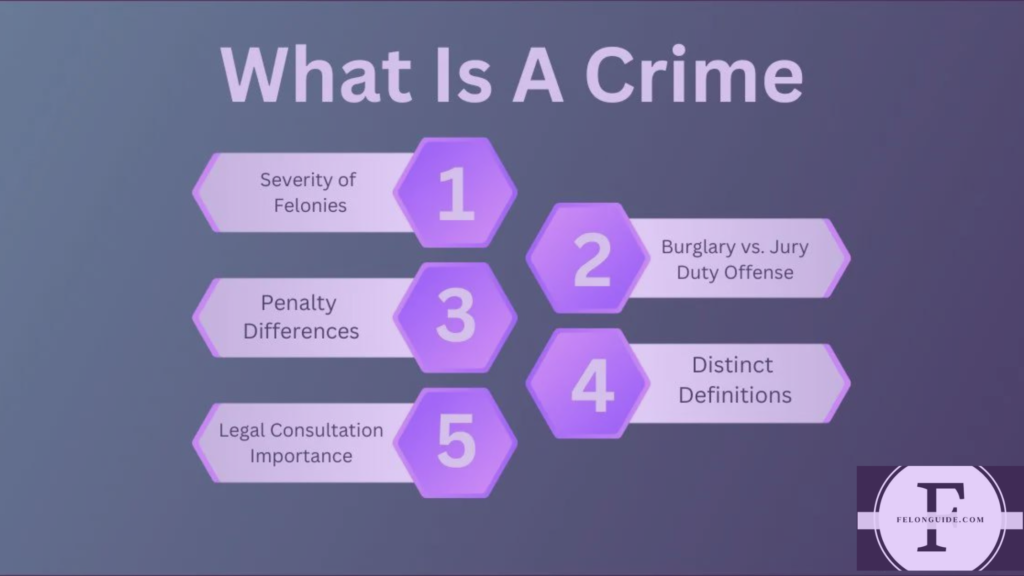What Is The Most Common Felony?
What Is The Most Common Felony? At first glance, this may seem like a straightforward question with a straightforward answer, but surprisingly, nothing could be further from the truth. In the United States, the criminal justice system consists of thousands of state, federal, and local systems, and the data these systems report is never presented in a neat package. From various forms of reported data, we can identify the most common crimes, but it is not possible to identify one crime as being more common than others.
What Is A Felony?

A felony is a serious criminal offense punishable by at least 1 year in prison. Even when a judge gives a lesser sentence, choosing probation over prison, the crime is still a crime. Less serious crimes, called misdemeanors, are punishable by fines and a maximum sentence of 1 year.
The least serious crimes are called violations. Violations do not carry jail time. Corruption is punished in local prisons. Serious sentences are usually served in state and federal prisons, although some local jails also house offenders.
The 4 Categories With The Most Common Felonies

Crime falls into broad categories, so we’ll start with those categories, and then focus on the most common crimes within each group.
The most common offenses are grouped into:
Drug crimes.
Property crimes
Offenses against public order
Violent crimes
According to data analyzed by the Prison Policy Initiative, there are currently 110,000 inmates in state prisons serving time for public order crimes, 132,000 for serious drug crimes, and 142,000 for property crimes. are, and 656,000 have been convicted of a violent crime after the crime.
Continuing these categories, federal prisons hold another 61,000 public order offenders, 69,000 drug offenders, 11,000 inmates serving time for violent crimes, and 6,000 for property crimes. Local jails contain a mix of inmates convicted of less serious crimes and people awaiting trial who were either denied bail or could not afford it.
Of those awaiting trial, 135,000 are accused of violent crimes, 106,000 are charged with property crimes, 109,000 are charged with drug-related crimes, and 75,000 are in prison for public order offenses. are
Drug Abuse Felonies

Drug use offenses fall into 3 major groups:
- Drugs and drug paraphernalia
- Drug trade and distribution
- Preparation of medicines
- Possession of drugs can be a misdemeanor or a felony. The classification of the offense depends on the type and quantity of the drug.
Possession of a Schedule I or Schedule II substance often results in serious charges. Drug trafficking, drug distribution, and drug manufacturing are serious crimes. Penalties for first-time, less serious drug offenses typically range from 1 to 3 years in prison and fines of several thousand dollars.
Repeat offenders and those charged with more serious crimes face longer sentences and heavier fines. In state prisons, 34,000 offenders are serving time for drug possession, while 98,000 are behind bars for other drug offenses. Local jails house 11,000 drug possession offenders, 7,000 drug trafficking offenders, and 2,000 offenders convicted of other drug offenses. There are 109,000 people in prison awaiting trial for drug offenses.
Property Crimes
The main property crimes are:
- Burglary
- Vehicle theft
- Fraud
- Arson
- Larceny
- Other theft
Property crimes can be misdemeanors or felonies, depending on state law and/or the scale of the crime. Burglary is the most common crime in this category and occurs when someone enters a building without intent to commit a crime.
First-degree burglary which involves entering a person’s home is always a felony. Other types of theft can be prosecuted as misdemeanors or misdemeanors. A felony theft conviction usually results in a custodial sentence of at least 1 year, although probation is sometimes an alternative option.
Depending on the circumstances surrounding the theft and state law, felony theft convictions can lead to a sentence of 20 years or more. 80,000 inmates in state prisons are serving sentences for felony theft. Five thousand convicted burglars are behind bars in local jails, and another 33,000 are awaiting trial on theft charges. State prisons also hold 13,000 for fraud, 7,000 for car theft, 27,000 for burglary, and 15,000 for other property theft offenses.
Public Order Offences
Crimes against public order are illegal acts that violate social policy, public opinion, or moral values.
Some types of low-level drug offenses are treated as public order offenses. Other public order offenses include but are not limited to:
- Possession or Possession of Prohibited Weapons
- Parole or probation violations
- Obstruction of justice
- Driving while intoxicated
- Immigration Crimes
In state prisons, offenders incarcerated for public order offenses include 39,000 with weapons convictions, 15,000 with DUI convictions, and 56,000 for other public order offenses. A further 27,000 criminals have been convicted of public order offenses in local jails, with 75,000 awaiting trial. Penalties for public order offenses vary widely. The penalty for DIU is a minimum of 1 year for a less serious offense, or up to 15 years if the offense resulted in bodily injury.
Violent Offenses
Violent crimes are usually felonies. Classifications of violent crimes include:
- Murder
- Massacre
- Rape/Sexual Assault
- attack
- Robbery
Other crimes are considered violent crimes when force is used even when there is no physical violence. What violent crime is most common in state prisons? According to the Prison Policy Initiative, rape/sexual assault is the most common crime with 163,000 offenders serving time in state prisons.
The punishment for rape depends on state law, the age of the victim, and the circumstances of the crime. The penalty for rape without aggravating factors is less than for rape with the use or threat of deadly force.
Punishments can range from 2 years to life imprisonment. State prisons hold 158,000 murderers, 146,000 rapists, 132,000 for robbery, 19,000 for murder, and 40,000 on death row for other violent crimes.
A small number of convicted felons are held in local jails, with 1,000 murderers, 1,000 rapists, 500 convicted murderers, and 3,000 convicted robbers. Prisons also hold 135,000 people awaiting trial for violent crimes.
What Crimes Are Felonies?

Serious crimes are those punishable by at least 1 year in prison.
Violent felonies include:
- Murder
- Manslaughter
- Robbery
- Rape
- Sexual assault
- Child molestation
Serious drug felonies include:
- Manufacturing illegal substances
- Drug trafficking
- Drug distribution
- Drug possession
Serious property felonies include:
- Arson
- Grand theft
- Vehicle theft
- Burglary
- Fraud
Serious public order offenses include:
- DUI
- Carrying restricted weapons
- Parole or probation violations
- Immigration offenses
Some crimes can be prosecuted as felonies or misdemeanors. The difference will be based on state law, the circumstances of the crime, and whether the accused is a repeat offender.
Summary
Violent offenders are the most common offense category in state prisons, accounting for the largest number of inmates.







